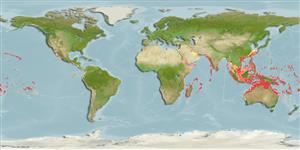Common names from other countries
>
Mulliformes (Goatfishes) >
Mullidae (Goatfishes)
Etymology: Parupeneus: Latin, parum, parvum = small + Peneus, the name of a river.
More on author: Bennett.
Environment: milieu / climate zone / depth range / distribution range
Ecología
marino asociado a arrecife; rango de profundidad 1 - 120 m (Ref. 89972). Tropical; 30°N - 30°S
Indo-Pacific: East Africa to Hawaii and the Line, Marquesas and Tuamoto islands, north to the Ryukyu Islands, south to Lord Howe and Rapa islands.
Tamaño / Peso / Age
Maturity: Lm ? range ? - ? cm
Max length : 33.0 cm TL macho / no sexado; (Ref. 9710); common length : 20.0 cm TL macho / no sexado; (Ref. 30573); peso máximo publicado: 906.00 g (Ref. 4887)
Espinas dorsales (total) : 8; Radios blandos dorsales (total) : 9; Espinas anales: 1; Radios blandos anales: 7; Vértebra: 24. Diagnosis: Pectoral rays 16 (rarely 15 or 17). Gill rakers 6-8 + 21-25 (total 28-32). Body depth 3.45-3.95 in SL; head length (HL) 2.85-3.1 in SL; dorsal profile of snout straight to slightly convex, the snout length 1.7-2.05 in HL; barbel length 1.3-1.55 in HL; longest dorsal spine 1.4-1.7 in HL; last dorsal soft ray of adults longer than penultimate ray, the latter contained 1.1-1.25 in length of the former; posterior margin of caudal-fin lobes straight to slightly convex; pectoral-fin length 1.3-1.5 in HL; pelvic-fin length 1.25-1.45 in HL. Body pinkish to yellowish gray, the scale edges narrowly dark, with a black spot about 3-4 scales in width on lateral line below posterior part of first dorsal fin, followed by a large pale pink to white spot; a blue spot often present on each scale above lateral line, always present posteriorly; pale blue spots, one per scale, ventrally on body, but often not visible; short blue lines radiating from eye except ventrally; barbels pale pink to white; basal third of second dorsal fin with a broad black or blackish band or a large black spot, sometimes extending onto adjacent back, the outer part of fin with narrow blue and yellow bands; anal fin with faint pale blue and yellow bands; remaining fins varying from yellowish gray to light red (Ref. 54393).
Primarily an insular species (Ref. 30573). Usually solitary, it occurs in seagrass beds (Ref. 41878) as well as over sand, rubble, or coral and rock bottoms of shallow lagoon and seaward reefs to a depth of at least 46 m (Ref. 30874). Benthopelagic (Ref. 58302). Feeds on benthic animals like crabs, polychaetes and other worms during the day (Ref. 30874), also shrimps, heart urchins, gastropods, pelecypods, foraminiferans, brittle stars, and fishes (Ref. 37816).
Life cycle and mating behavior
Maturities | Reproducción | Spawnings | Egg(s) | Fecundities | Larva
Randall, J.E., 2004. Revision of the goatfish genus Parupeneus (Perciformes: Mullidae), with descriptions of two new species. Indo-Pac. Fish. (36):64 p. (Ref. 54393)
IUCN Red List Status (Ref. 130435)
CITES (Ref. 128078)
Not Evaluated
Threat to humans
Harmless
Human uses
Pesquerías: escaso valor comercial; pesca deportiva: si; Acuario: Comercial
Herramientas
Special reports
Download XML
Fuentes de Internet
Estimates based on models
Preferred temperature (Ref.
115969): 24.3 - 29, mean 27.8 (based on 1504 cells).
Phylogenetic diversity index (Ref.
82804): PD
50 = 0.5000 [Uniqueness, from 0.5 = low to 2.0 = high].
Bayesian length-weight: a=0.01202 (0.00556 - 0.02601), b=3.10 (2.93 - 3.27), in cm Total Length, based on LWR estimates for this Genus-body shape (Ref.
93245).
Nivel trófico (Ref.
69278): 3.4 ±0.2 se; based on diet studies.
Resiliencia (Ref.
120179): Medio, población duplicada en un tiempo mínimo de 1.4-4.4 años (Preliminary K or Fecundity.).
Fishing Vulnerability (Ref.
59153): Low vulnerability (23 of 100).
